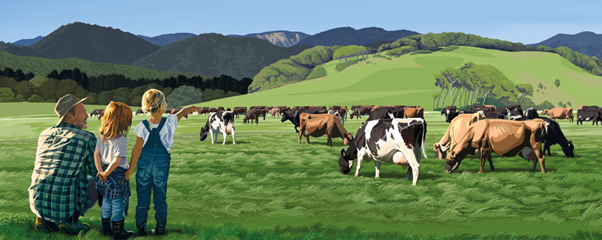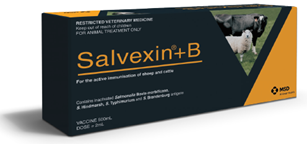

Salvexin®+B
New Zealand’s only Salmonella vaccine for cattle

Salmonella is widespread on New Zealand farms and 2 times more prevalent than in 2013
Surveillance MPI,2013-2024.
Listen to Dairy Exporter podcast 39 HERE: How to prevent a devastating Salmonella outbreak
Benefits of preventative vaccination with salvexin+B
- Increases immunity to Salmonella bacteria
- Reduces shedding which may help prevent Salmonella infection in other animals and in farm workers (zoonotic disease) through reducing environmental contamination1-3
- Minimises production and stock losses if disease occurs
Preventative vaccination programme

For preventative vaccination. give two shots in the first year (sensitiser and booster) at least 4 weeks apart. The second shot should be at least 2-3 weeks before the risk period. An annual booster is required for ongoing protection.
WHEN TO vaccinaTe
The booster shot (second shot in first year, or single annual booster in subsequent years) should be given at least 2-3 weeks before the risk period. Field experience suggests that a practical time to vaccinate for dairy farmers is around late pregnancy before drying off. Use in later pregnancy has risks, discuss with your vet.
vaccination in the face of an outbreak
In the face of an outbreak, vaccination should be as early as possible to reduce stock losses.
If a disease outbreak occurs, consult your vet as soon as possible as different approaches are recommended depending on the situation.
FIND OUT MORE ABOUT SALMONELLA
Salmonella is a bacteria spread by healthy carrier animals via their intestinal tract. Cattle may not show signs of disease, but shed bacteria (usually intermittently at low levels) via their faeces. Abortive material can also be infective, spreading bacteria to other animals. These bacteria go on to infect other animals. Carrier animals can shed Salmonella for months or even years.
There are many different strains of Salmonella in New Zealand, with the most prevalent in cattle being:
- Brandenburg (primarily causes abortions)
- Typhimurium (primarily affects the gut (enteric))
- Bovismorbificans (primarily affects the gut (enteric))
- Salmonella Give (primarily affects the gut (enteric))
Irrespective of the strain, all types of Salmonella can cause outbreaks and deaths.
The most common way Salmonella is introduced to a farm is through healthy looking carrier animals (cattle, sheep etc.).
Higher risk practices include:
- Off-farm grazing
- Intensive feeding
- Purchasing/leasing stock
- Shared boundaries/stock yards
The number of animals that become infected, ill or die depends on the risk factors on farm. Reducing these risks is the first step to helping prevent an outbreak.
- Minimise time off feed when yarding/transporting
- Reduce stock density
- Separate stress events such as trucking and vaccinations
- Control pests and scavengers
- Vaccinate at risk cattle preventatively around dry-off.
If a disease outbreak occurs, consult your vet as soon as possible. Different approaches are recommended depending on the situation.
Farms at risk of Salmonella should consider preventative vaccination.
References
- Royal W, Robinson R & Duganzich, D. (1968) Colostral immunity against Salmonella infection in calves, New Zealand Veterinary Journal, 16:8-9, 141-145
- Li H, McFarlane R, & Wagner J. (2005) Vaccination of pregnant ewes against infection with Salmonella Brandenburg. New Zealand Veterinary Journal 53(6):416-22.
- Clark et al (2011) Salmonella in animals in New Zealand: the past to the future. NZ Veterinary Journal, 50: 3, 57-60


